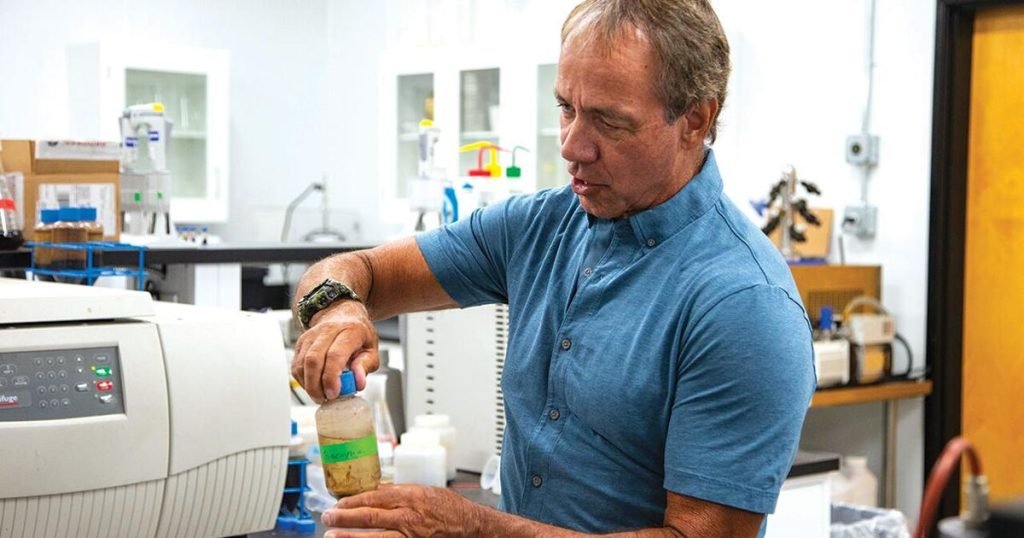Daniel Hilger has been plowing the soil for more than half a century since he was old enough to carry buckets of feed to his pigs.
And for over 30 years, Nebraska farmers have used humic-based produce in their crops, which has improved soil conditions and yielded stronger plants.
Hilger Agri/Natural Popcorn owner Hilger said in a 2019 podcast, “When you get healthy plants, they ultimately taste better and are healthier for those who eat them.” will be,” he said.
A company advancing the science of improving crop yields by extending the shelf life of fruits and vegetables and making them tastier is Huma, located near McQueen and Guadalupe streets in Gilbert.
Huma manufactures and wholesales an extensive product line to distributors throughout the United States and 35 countries, including China, Israel, Italy and Mexico. End users are farmers such as Hilger.
Founded by plant physiologists Dr. Jordan Smith, Don Ogan and Delworth Stout, Huma took root by purchasing a mountain 50 years ago.
“They started the company in 1973 out of a mine in southwestern Idaho,” explained Lyndon Smith, CEO and president of Huma Corporation, which is 80% employee-owned.
After acquiring the mountain, the Sunburst Mining Company was established in Mesa and “started mining this raw material,” Smith said. “It’s a unique material that, if applied at 40 to 50 pounds per acre, would make a big difference in agriculture.
Ingredients included humic substances, natural organic biostimulants derived from decaying plant and animal matter over time.
“It will stimulate growth, increase plant vigor, improve soil conditions – properties such as water holding capacity and nutrients available to plants – and increase yields,” Smith said. “If you are healthy and strong, you are less likely to get sick. The same applies to plants and crops.”
secret technique
The secret to Huma products is a proprietary blend called Micro Carbon Technology (MCT), which are concentrated small organic particles extracted from the humates of the Idaho mine.
According to the company, Huma products containing MCTs enable a highly precise delivery of nutrients to improve crop vigor, quality and yield.
“No one has microcarbon technology, it was developed by my father and the founders of the company,” said Smith, who took over the company’s management in November 1994.
Smith is not a scientist. The Mesa resident has a bachelor’s degree in finance and a law degree, but he says he knows more about agriculture than law.
A team of scientists continues research initiated by the company’s founders.
“We try to find and hire the best humic substance researchers in the world,” Smith said. “We do this because we want to know everything about humics, so we have the best.”
The Senior Director of Research is Dr. Richard Lamar, who oversees a team of four other employees with PhDs. During his company tours, he admired the benefits of humic substances, such as strengthening the thin roots of plants.
“Strengthening thin roots allows plants to take advantage of increased soil loading,” Lamar explained. “If you have two routes, you are limited.
“This is a big thing, and we also found that our product increased photosynthetic efficiency. So, more of plant biomass, which we hope will lead to increased productivity, because that is the end goal.”
He said farmers applying Huma products to their crops expect returns on their investment, such as more bushels of corn per acre.
According to Lamar, humic acid also helps the plant’s stress response.
“Global warming is putting more stress on crop plants these days,” he noted. “We give them a little bit of stress to make them stronger.”
According to Lamar, changes in a plant’s stress response make it better prepared to deal with the stress posed by conditions such as drought or too much rain.
“I like to tease that it’s like going to the gym and working out,” Smith interjected. “Breaking down muscle will make you stronger in the future.”
The company’s Idaho mine won’t run out of key raw materials anytime soon. “In terms of material from Idaho, it’s a whole mountain and we don’t harvest much,” Smith said. “It’s been years since we’ve been mining.”
In fact, according to Smith, at least 20 years’ worth of humates have been stored in an unremarkable mound of dirt brought from the Chandler site during the 1978 move.
The company also extracts humic substances from the mountains of New Mexico, where it has contracted reserves for more than 20 years. Raw materials there are regularly mined and sold to manufacturers to make their own humic-based products, Smith said.
Proven results
According to Smith. Crops grown with Huma products save water.
“On average, we save about 30 percent water, which is huge in Arizona agriculture,” he said.
We’ve also seen 10-20% increases in crop yields, but more importantly, Smith said quality is where Huma products really shine.
“We can increase the shelf stability of that crop,” he said. “For example, we have shown that peppers grown in our product can be kept for an additional week on store shelves and in the consumer’s refrigerator.
“We have shown that the same peppers have more magnesium and more nutrients than conventionally grown peppers.
And “you can definitely taste the difference,” Smith said.
“I feel sweeter.
We moved to Chandler in 1978, five years after starting the company in Mesa. In 2011, Gilbert moved to a larger drilling site of 4.5 acres to allow for expansion.
Huma’s current roster includes 55 in Arizona, 25 in New Mexico, 14 in Mexico, and 6 in Brazil.
The company celebrated its 50th anniversary in June and announced a name change from Bio Huma Netics to Huma. The company also merged six brands under the Huma brand name and unveiled a new tagline, “Humaic Solutions with a Human Touch.”
But despite its patented technology, Smith says the company is still a small player in the $130 billion fertilizer industry, and Huma has done a better job of telling its story. added that you need to
He said the company has been selling more of its products outside the U.S. for several years now, and sales are now split almost evenly between domestic and international markets.
But he said he has struggled to market Huma products to farmers in Arizona, who see them as “snake oil.” Instead, they stick to conventional fertilizers.
Arizona is the fourth largest vegetable producer in the nation, and Yuma County is one of the largest producers of winter vegetables.
“The reality is that we are real,” Smith said. “We’ve been going on for 50 years, so I think they’ll realize, ‘Oh, it must mean something.'”
Nebraska farmer Hilger said when he first applied Huma’s biostimulant product to his corn, he thought, “Oh my God, I really feel like my corn has improved that year.”
Hilger has also visited many farmers in Washington, Oregon, and Idaho who use Huma products, and the common theme is that “their plants are healthier, more resistant to pests, and less susceptible to chemicals.” is not needed so much.” I was using
Smith said combining MCTs with nutrients is “much more efficient.”
“So we’re getting up to 10 times more efficient, but the least efficient product is nitrogen, which is only twice as efficient,” Smith said. “But everyone in agriculture talks about 25% efficiency, and we talk about his 100% efficiency, so this is more efficient than conventional fertilizers.”
The company’s best-selling products are NPK fertilizer competitors nitrogen, phosphorus and potassium.
“Our typical usage is between one quart and one gallon per acre,” says Smith. “That is a very small amount compared to conventional fertilizers, which require one tonne of fertilizer per acre.”
The product is diluted with water and applied by ground sprayers or drip irrigation, and in many parts of the world by aerial application using aircraft.
“Prices are about the same as traditional exchanges,” Smith said. “We plan to apply much less in the future, but the cost per acre is about the same.”
eyes on the future
Nearly a year ago, Huma purchased a 40,000-square-foot building south of the Arizona State University campus in Tempe.
“We’re right next to the railroad, so the tracks will pass,” Smith said, adding that the company has been waiting six months for the city to get a hazardous materials permit to occupy the building. rice field.
“Our intention is to slowly transfer blending and packaging from here to that facility,” he said.
Most of the company’s packaging is done in 2.5 gallon jugs. Liquid products sent overseas are placed in 1,000 liter totes for packaging at their destination.
The Gilbert site will be the hub for product development and improvement, product quality assurance, and humic substances research.
Smith said the company’s goal is to become a world leader in Humic products and technology.
“We want to provide solutions for today’s agriculture,” he said. “The challenges facing agriculture today are over-application of chemicals, the use of salt-based fertilizers and simply being unfriendly.
“By combining our technology with other nutrients, we make them more accessible and have a much lower environmental impact. It is truly sustainable and renewable agriculture.”
Smith said Huma is a key figure in the biostimulants movement that has been going on in the United States and Europe for several years.
“There’s a shift happening in agriculture where farmers are trying to become more environmentally conscious,” says Smith. “They know some of what they have applied is not good, especially because the older generation is dying out.
“They are dying from lung problems and other problems related to the chemicals they have used over the years.
Smith takes sustainability seriously.
The company also purchases label printers to reduce waste and recycles all junk such as cardboard and virgin plastic.
“I’m tormenting myself as a guy from Arizona,” Smith said. “This company has taken me all over the world and it has been amazing.
















